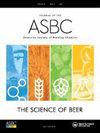Hyperspectral Imaging Technology Combined with the Extreme Gradient Boosting Algorithm (XGBoost) for the Rapid Analysis of the Moisture and Acidity Contents in Fermented Grains
IF 1.8
4区 农林科学
Q4 BIOTECHNOLOGY & APPLIED MICROBIOLOGY
Journal of the American Society of Brewing Chemists
Pub Date : 2023-10-10
DOI:10.1080/03610470.2023.2253705
引用次数: 0
Abstract
AbstractThe moisture content (MC) and acidity content (AC) of the fermented grains used in liquor production directly affect the liquor quality and yield; as such, they are important indicators used to evaluate the quality of fermented grains. In this study, extreme gradient enhancement algorithm (XGBoost), partial least square regression (PLSR), and extreme learning machine (ELM) models were developed based on spectral data collected by near-infrared (NIR) hyperspectral imaging (HSI) technology. First, PLSR models were established after SNV and MSC algorithms preprocessed the HSI data, and the best preprocessing method was determined (MC: SNV; AC: MSC). Then, the competitive adaptive reweighting sampling (CARS) algorithm and principal component analysis (PCA), both combined with the successive projection algorithm (SPA), were used to extract the characteristic wavelengths from the full-band spectral data. Ultimately, the XGBoost model developed using the characteristic wavelengths extracted by CARS-SPA most accurately predicted the MC (RPD = 6.4167, RP2 = 0.9757, RMSEP = 0.0442 g·100 g−1) and AC (RPD = 13.0308, RP2 = 0.9941, RMSEP = 0.0216 mmol·10 g−1). The results showed that the XGBoost model could more accurately predict the MC and AC of the fermented grains from hyperspectral images of the grains, providing an effective method for the rapid analysis of raw materials used in the fermentation of liquor.Keywords: Characteristic wavelengthshyperspectral imaging technologyliquor fermented grainsmoisture and acidityvisualizationXGBoost AcknowledgmentsMoreover, thanks to Jianping Tian and Xinjun Hu for providing theoretical and financial support. Thanks to Xinna Jiang for providing valuable advice and guidance.Author contributionsLipeng Han: writing—original draft, writing—review and editing. Xinna Jiang: resources. Shuyu Zhou: resources. Jianping Tian: supervision. Xinjun Hu: supervision. Dan Huang and Huibo Luo: resources.Disclosure statementNo potential conflict of interest was reported by the author(s).Data availability statementThe data that support the findings of this study are available from the corresponding author upon reasonable request.Additional informationFundingThe authors are grateful to the Luzhou Laojiao Innovation Fund of Sichuan University of Science and Engineering (LJCX2022-9) for its support. This research was also supported by Sichuan Science and Technology Program (2022YFS0552) and the Liquor Making Biological Technology and Application of Key Laboratory of Sichuan Province (NJ2022-04).结合极限梯度增强算法(XGBoost)的高光谱成像技术用于发酵谷物中水分和酸度的快速分析
摘要白酒生产中使用的酒糟的水分含量(MC)和酸度含量(AC)直接影响白酒的品质和产量;因此,它们是评价发酵谷物品质的重要指标。本文基于近红外(NIR)高光谱成像(HSI)技术采集的光谱数据,建立了极值梯度增强算法(XGBoost)、偏最小二乘回归(PLSR)和极值学习机(ELM)模型。首先,通过SNV和MSC算法对HSI数据进行预处理,建立PLSR模型,确定最佳预处理方法(MC: SNV;AC: MSC)。然后,采用竞争自适应重加权采样(CARS)算法和主成分分析(PCA)算法,结合逐次投影算法(SPA)从全波段光谱数据中提取特征波长;最终,利用CARS-SPA提取的特征波长建立的XGBoost模型最准确地预测了MC (RPD = 6.4167, RP2 = 0.9757, RMSEP = 0.0442 g·100 g−1)和AC (RPD = 13.0308, RP2 = 0.9941, RMSEP = 0.0216 mmol·10 g−1)。结果表明,XGBoost模型能较准确地预测酒糟的MC和AC,为白酒发酵原料的快速分析提供了一种有效的方法。关键词:特征波长;超光谱成像技术;白酒发酵颗粒;水分酸度可视化;感谢蒋新娜提供的宝贵建议和指导。作者:韩世鹏:写作-原稿,写作-审稿,编辑。蒋新娜:资源。周树宇:资源。田建平:监督。胡新军:监督。黄丹、罗惠波:资源。披露声明作者未报告潜在的利益冲突。数据可得性声明支持本研究结果的数据可根据通讯作者的合理要求获得。作者感谢四川理工大学泸州老窖创新基金(LJCX2022-9)的支持。四川省科技计划项目(2022YFS0552)和四川省酿酒生物技术与应用重点实验室(NJ2022-04)资助。
本文章由计算机程序翻译,如有差异,请以英文原文为准。
求助全文
约1分钟内获得全文
求助全文
来源期刊

Journal of the American Society of Brewing Chemists
工程技术-生物工程与应用微生物
CiteScore
4.00
自引率
20.00%
发文量
41
审稿时长
3 months
期刊介绍:
The Journal of the American Society of Brewing Chemists publishes scientific papers, review articles, and technical reports pertaining to the chemistry, microbiology, and technology of brewing and distilling, as well as the analytical techniques used in the malting, brewing, and distilling industries.
 求助内容:
求助内容: 应助结果提醒方式:
应助结果提醒方式:


